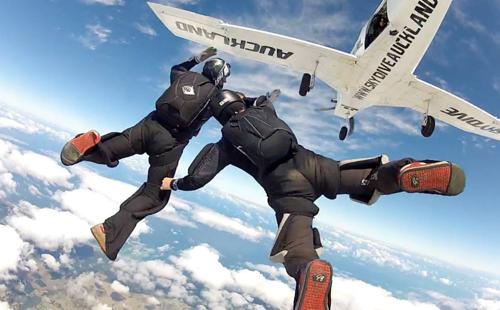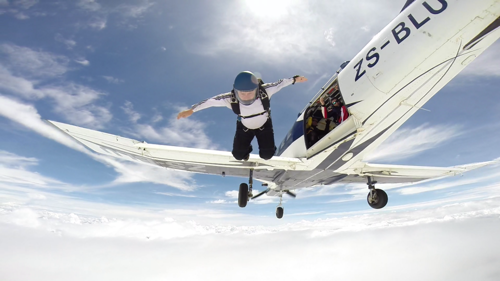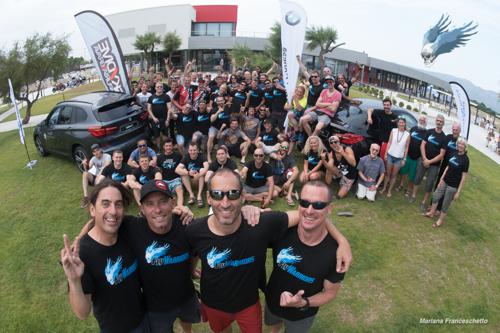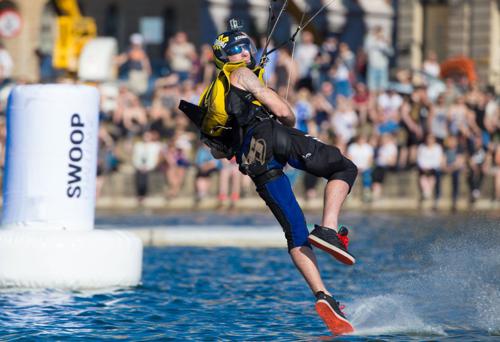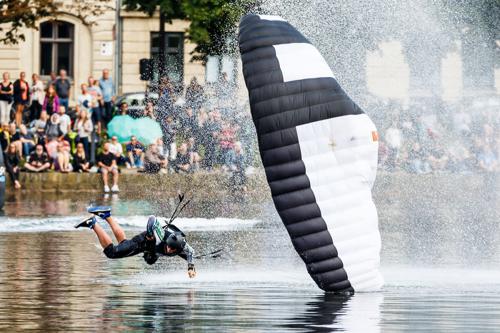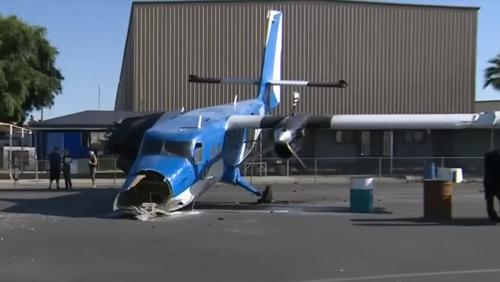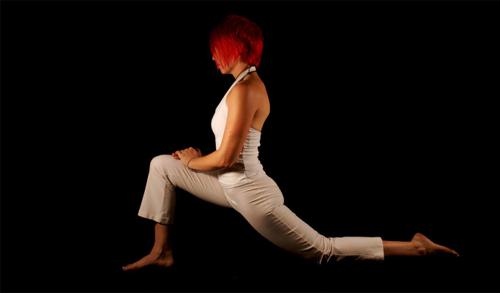Last June a new European head up record was set. 43 skydivers (plus 2
cameramen) in the sky of Empuriabrava broke the previous 21-way record. Fly
Warriors, a team of 4 talented freeflyers, was behind that achievement. Three of
them, David Nimmo, Luis Adolfo Lopez-Mendez and Gustavo Cabana visited the
Belgian sky during the Flanders Boogie. I had the opportunity to interview them
and get some insight of how this was done. After thanking them for accepting
the interview, this is how the conversation went like.
Who are Fly Warriors? Tell me a bit of your history, previous teams, how you've gotten together...Nimmo: Luis and I were both members of Babylon freefly for
many many years. Around 2015 this was coming to an end, the end of an era, and
being still very keen to push the sport and not to pull back the reins in and
slow down, we combined with a 3rd guy -Raph Coudray-. He had just finished competing in VFS in one back to back world championship. It was kind of a natural
thing forming something together. And then we added a couple of young guys -Leo and Gyzmo- into
the team with similar ideas and did a 4 way dynamic team, which actually won the
world championship together. That kind of was the first year. Then Leo and Gyzmo wanted to focus on tunneling. And with Gus, we needed
video with obviously steady imaging and high quality. His level in freefly has
improved a lot in the last years, he has put a lot of effort on in, and we
asked him to join. And that's how we've got on. Real
professionals, independent, autonomous, all of us doing our own thing, but we
come together to do advanced and worthy stuff. So these jumps (head up European record) is how we do it.
Luis: One of the rules to become a Fly Warrior is that you need to be
over 40 (laughs).
Damian: So if you guys meet somebody young but really great... he
simply has to wait.
Nimmo: Too immature. At 40 you start to be a man maybe (laughs).
Fly
Warriors (From left to right: Gustavo Cabana, Raphael Coudray, Luis Adolfo Lopez-Mendez, David
Nimmo) with the record holders and the rest of the crew. Photo: Mariana
Franceschetto
Empuria seems to be
Europe's skydiving capital. What is the reason for that, what makes it so
special in your opinion?Gustavo Cabana: Empuria has over 30 years of history and during that time
they had many events and teams who train there because of the
weather and the aircrafts. It is just the best place in Europe to skydive, the
weather, the aircrafts...
Luis: And the location.
Gustavo: And the location! The location is incredible. I think it is
the only dropzone in the world that is in the town. It is not in an airfield,
in the middle of nowhere, it is really in the side of the town. Every time
you go away to jump somewhere else and you come back you can't believe that.
As a photographer to have the chance to jump there, to have the sea, the mountains,
you know, it is kind of the perfect background.
You were the
organizing team for the recent European head up record. Congratulations for
that fantastic achievement. What drove you to take on that challenge? At which
point did you decide "we have to do this"?Luis: Nimmo and myself, when we were in Babylon, we were involved in
other European records, head down. Head up started to wake up and become what it
is today (with respect to records). So when we went from Babylon to the
Fly Warriors Nimmo said to me that we should organize a head up record. And so
we decided to start with the first one, two years ago. We did a 21 way.
The problem is that the capacity of the planes is
limited. It is too expensive to have that many planes and to make it happen. So
being in Empuria with 3 planes made it easier to organize and we decided to put
the full fleet into work. And then we were thinking in starting a bit smaller,
but the two camps we organize in Empuria were really good and big and then the
feedback and registration for the record... we had to tell people to stop,
there was a waiting list. So we went for go big or go home, and we started with
slots and 2 camera flyers, which is the capability of the planes.
Nimmo: We basically maxed it out. To go any bigger we
would have to find money for other aircraft or another location. Europe or South
America don't have 5 Twin Otters or 7 Skyvans in the garage like in Eloy. So, it
is harder go to massiver. Shame.
How did you
organize the try-outs to attract jumpers from all over Europe? How was the
process of organizing the try-outs to select who is going to be part of it or
not. Was it enough with the camps you had in Empuria, or did you try to have
other people that you trust to organize some other camps, somewhere else in
Europe?Nimmo: To try and make it work, there is some smooth out. We had
different areas within Europe, like the German speaking section, the
Scandinavians, the English, the French... and for each area we had a team
captain. He was allowed to do some kind of trials to find out people of
this area that he would recommend to come to the record. So those 5 guys that
were part of that team had their job to do in the jump, and also to bring
people to us. It's helped to some degree but the biggest thing we did was some
try-out camps last year and 2 camps this year. We had a big interest in people
wanted to do head up, and we had the capacity maxed out in those camps. Most
people came from there. It worked out well. The
dropzone wants to do formation records. That's an offer than other places can't
do, that's a premium product that we have, and they are happy to that in the
future. So of course in the future if we can we will keep doing this up to 40
ways.
Base exiting from Twin Otter. Photo: Gustavo Cabana
The level has to be
super high once you select jumpers in the try-outs. How do you organize the
jump then? How do you decide who goes in which airplane, who is on base, who is
gonna sting it...?Luis: We try to find a slot for specific qualities. Maybe you are a
heavy person and fly strong, so we put you in the base. The first stingers are
people that can fly fast to get there. And then who closes
the pod needs to have the ability to grab 2 hands and then give shape to the pod. So we kind of
assess the people and give them a slot. We also had Antonio Aria taking care of
the bench. He is a very good organizer and part of the world record crew. And
in the last world record met with Raph Coudray and David Nimmo in Eloy. So that, combined with
our experience, the experience of the world record, and Antonio taking care of
the bench helped us to take decisions. When we needed to have a change we would come to Antonio and
say "we need a second stinger", and he would say "ok, from the
bench, this guy is rock solid. Now. Today". Because sometimes you have the
issue that you know people that are good flyers, but maybe they are having a
bad week or a bad day. And there is some other people that might not be that
strong, in paper, but that day they are on and then get on it. We had issues
with some flyers that were really good, but they had to be cut off, which it
was a surprise for me, and for sure for him. But then other people did their
job and at the end it is not a personal thing, we have a job to be done, and is
to get a record. It is a common goal
and not a personal goal. Which sometimes people don't understand. At the end,
after every record I tell Nimmo I won't never do this again -and then we do
another one-. Because you have 45 people that love you, then 15 that understand
that they had a very good training with the bench group, and 10 that don't like you
Damian: I guess it is also difficult if you have the level to be
there but are kicked out because you are not being consistent enough, I
guess... you know, it has to hurt your ego as well.
Luis: That's the biggest problem in skydiving at the end.
Damian: Ego?
Luis: Ego. Ego is a bitch. And it can kill you.
How did you decide
in other factors like altitude (did you take it as high as possible, decided to
do something lower...), speed (does the base accelerates or slows down, how
much...), shape of the formation, number of people on base, number of people on
base during exit.... How do you decide about all those details?Nimmo: Experience. We have done it enough and we trust that gut.
The formation is just a standard formation, a round thing with
round things attached to it. The base of whatever size and then you connect
pods like doing Lego. So there is nothing really to think about. And with Luis'
experience and Raph's, we look at people and we decide where they are gonna be.
Then you make mistakes and they might not be in their best place so you move
them around. But the most important thing for me is that we had a good base.
This is the key. If you have planes doing their job, the base doing
its job then you just have to take the picture. That's it. If the planes make a
mistake, they are too far away, whatever. The timing of the exit. Or the base
makes a mistake. Then for sure I guarantee nothing is gonna happen.
Luis: But everything starts from the number of people we are gonna
use. Nimmo and myself were discussing for a few months already about how much
people we are going to have in the base, if it is going to be 6 or 8 or 10. If
we have enough people to do that base, to do the pods, what is going to be the
shape... Like he says, we kind of go with the feeling. We can do this and we
put it on paper. We do on the first attempt what we think is best, and then you
realize that this person can be better here or there. So you start moving
pieces around so the structure is more solid.
Nimmo: We had a struggle with the beat. We did 6 jumps a day, which
is a lot to 18000 feet. In the 2 and a half days that took us to do the record
we did 16 attempts. Which is a lot of fucking work. So we really pushed it when
we had the conditions. We could have problems with the weather... there
are so many variables.
Gustavo: The thing with a record is that you need more time, no? So
why don't you go to 20000 or 25000? The problem when you go past 15000 is that
there is less oxygen and people are more prone to have hypoxia. For that we use
oxygen onboard, which helps you to keep sharp. But also because the planes need to climb
in formation, it takes longer to go up and it is kind of... I think we found
over the years that going to 18000 or 19000 maximum is a good compromise between
the effort to climb and what you are going to get for the extra time in
freefall. Also in the head down and head up world records we went to 18000-19000.
The challengers getting together during one of the attempts. Photo: Gustavo Cabana
It took 16 jumps to
get the formation completed. How was the atmosphere before that? Were you
absolutely confident you would make it?Nimmo: I mean, yeah. For sure the last 2 jumps... in the last one
too... we were flying very strong. We knew we would get a record. We started to
cut. We said 45... now we need to get a result. 44. We didn't get it. 43. Done.
The head up world
record is a 72 way, done in Skydive Arizona. Do you see that as an attainable
number in Europe? Or are we limited because of the size of the dropzones and
the number of planes there?Nimmo: It is logistics. You need to get sponsors that say "fuck
let's make this happen, here you have 20 grand, two more planes". Hell
yeah. But otherwise we have to pay. We, as the flyers. And there is a point
where you go "I rather spend that money doing other cool shit". The
record is very cool and it goes in the history books. It is an
achievement for all the participants. But you are still limited by how much you
have to pay for that. So yes, it is possible, but you need some extra sponsors.
Gustavo: 3 years ago we did a world
record with 106 people (FS sequential). But the thing is that bringing the
planes there is super expensive. And if that money has to come from the pocket
of the skydivers... it is too much money. It is really expensive to fly a plane
to a dropzone.
Luis: And it was happening, this 100+ way because Dubai helped financially to make it happen.
Gustavo: If not it is impossible.
Nimmo: It is possible, but we need someone to support it. But, why not?
Shall we look? Maybe we get hungry in a year or two.
Luis: That's why we stopped with the head down once. Basically.
Nimmo: Logistics. That's about flying at the end of the day. Because
if you have to choose between logistics and not flying you go "fuck this,
I want to fly". So there is also that trade off in the equation as well.
How much you want to work on the ground to make it happen, but all you want to
do is flying.
Luis: There is a lot of work behind the scenes. Registrations,
payments, getting everything done... The good thing about our team is that
everyone has a speciallity. And we combined them, and we do whatever we do
strong. We are lucky that we have a very experienced camera flyer plus he is
really experience with oxygen. So we have that part covered. Nimmo and me don't
have to think about it. Nimmo has a lot of experience organizing big ways. And that experience helps you to do the
things. Me and Nimmo are taking care of the administration as well. Receiving
and sending emails. Nimmo was talking to the captains, I was organizing the
payments...
Nimmo: Judges, T-shirts.... Bullshits that are just as important. And
we all do that without effort. You don't have to grab anyone and tell them
"do this" like a child. It is just "Hey, could you do this?
-Yeah, sure". And it gets done. So this
also makes the team mature enough to realize you have to do something to make it
work and to do that without having to be hit with a stick.
Luis: And how it works, I don't know. Because we are 4 alpha...
Nimmo: Yeah, 4 alpha males, and we don't kill each other, that's rough.
Damian: That's already an achievement (laughs).
Luis: That's an achievement right there.
Nimmo: Because we are more than 40. After 40 you can work together.
Luis: But I think that's the key, you know? You have things that
bother you about each other, because we are humans. But we are old enough to
either talk about it or understand that no one is perfect and you have to deal
with humanity.
Initial
attempt diagram. 44 and 45 were cut off for the final record.
One of the mottos
of the record was "make head up great again". Why did you came up
with it? When did it stop being great?Nimmo: That was because head up was kind of neglected. Head down
records started in whatever it was... 21-way in Florida in 2001... when the 1st
head up world record was in 2015 or something. That's 14 years neglected. For
no reason. Head down has got massive, 164. Head up was nothing. So I was
talking with Steve Curtis, a good friend of mine from Eloy. He thought "let's do a 30 way" the first one. They
did 52! You couldn't believe it! Because it was just left on the
shelf, blow the dust off and it was ready to go. So make head up great, bring
it to the level it deserves. It is even more fun to fly, easier visually, it is
more of human kind of orientation, it is better, for sure, its fun.
Damian: That's funny that you chose the word "neglected"
because I had a follow up question that used that word. Do you think it has
been neglected in favor of head down?
Nimmo: Head down is easier to build. Head up for sure its hard. You have to get
in there, be humble and give it a try, and you have to work much harder. But
visually it is easier, its more natural. People look like human beings not
assholes and feet (laughs). But to be
there you have to put a lot of work. Work really hard. But then it is super
good. And it is so small! There is the 72-way, so we can get a head up record
every year to get it up to 150 or something. I mean, it won't be like that
but...
What was in your
opinion the biggest challenge of the record? What's the part that you've found
more difficult? Was it the flying, finding the right people, nothing of it was
really a challenge?Nimmo: The whole thing is this one big fucking package. So you just
have to do it all. Was this harder than that? It doesn't matter, you have to do
it anyway.
Luis: The situation with the record is that it doesn't matter if we
flew 42 way for 20 seconds and one person is missing. There is no record. Or 43
flew for one minute but the camera didn't work, you know? Or 2 planes were
super good and then one plane just lost it and people don't arrive. So at the
end everything has to work, like Nimmo says. The pilots need to work together
so we have a good drop, then the base has to be solid and then from there you
start to construct. The camera needs to be in the right place, take the right
shot so the judges can validate it. So, I would say, there is nothing more
important than other things, because without the pilots we could not do it,
without the base we could not do it, without stingers we could not do it,
without the second stingers we could not do it, without the pod closers as
well, without the cameras you can not, without the oxygen....
Nimmo: Just before, until
Sunday it was fucked up weather. And then hallelujah, we had blue sky. We were blessed with the
weather. Again, that's another factor and you can't control it. But it would
have been very frustrating that being the fucked up. But it wasn't.
Luis: And then everyday you need a lot of work after the jump and
before the jump. At nights, Gus can tell you, how much work he has to do to
prepare the planes to be ready to go.
Gustavo: Yes, because after every couple of jumps we need to exchange the
oxygen bottles. Attach them to the plane, the regulators. And sometimes the plane runs out of oxygen,
and people are waiting... It is kind of stressing, but at the
end of the day you have to do it, and when it works it is very satisfactory.
I was on the boarding area with my rig and I had to
check and make sure that every airplane had oxygen to go up. Because I've been
in many occasions in other records when you go to altitude, and they cancel the
jump because one plane run out of oxygen. And we had all to come down. It
happened many times. Minimum 4 times in 4 different events.
Damian: It has to be frustrating.
Gustavo: Specially if you are the responsible for that. Everybody
wants to kill you (laughs).
43-way formation completed. Photo: Gustavo Cabana
Who do you think is
going to organize the record that will break yours? When and by how much? If
that happens!Luis: What do you mean? In Europe?
Damian: Yes.
Luis: We will try to organize all the records in Europe.
Nimmo: This is the best you could do. So if somebody wants to do it
again... well, show me. In the history of records normally the dropzone or
group that organized the previous one they do it again. The Arizona crew do the head up records.
Rook Nelson does it with the head down records. Not because nobody else can do it,
but because these guys really do it. If Rook said "fuck head down I am not going
to do it" for sure someone will pick it up and try to run with it. But
then, they don't have the experience. So it also makes sense to go with the
guys who have done it once, twice, or five, six times.
If somebody else tried to organize it I would never try to do anything against it, you've got to
respect it. But the record is coming together, unified. We have to work
together or we are going to get nothing. Unified, together, big. Not your own
little shit.
Question for Gus.
The record is 43 people, plus cameramen. Gustavo, you were the wizard behind
the lens -with Will Penny as second cameraman-. You were also in other records.
How did you live each one of them?Gustavo: I always think that the cameramen are under pressure, but
not the same kind of pressure as the participants. Normally in a record we
have several cameras, so if one fucks up, the other one can have the shot. But
in the formation if one fucks up there is no record. Our pressure is more about
trying to be happy with us, with our job. The participants need to do their job
to get the record, and I feel like I need to take the best picture I can to be
happy with me. Also, I've been involved in records since many years, and what I
like about them is that everyone come together, to do something together. It
is not like in a competition where people compete against each other, and some
are going to be happy and some are going to be losers. And not only jumpers,
also people on the ground are helping you, your wife, your girlfriend, your
boyfriend, whatever, are there to help you to make it happen. The feeling you
have when is done is very unique. The feeling of unity and working together. I shoot almost every
discipline in skydiving: Belly, canopy formation, head down and head up. And at
the end I think that everyone has his own pace and feelings, but one feeling
that for sure is great is that you are taking a picture of the best skydivers
at that time in history. And it is a very good feeling to be part of that. It
is cool. Everyone there worked hard to be there. It is not like "I want to
do a record because I want to be cool". No, you need to work your ass off
to be a record holder.
European HeadUp Record 43 Way, June 23th 2017, Skydive Empuriabrava, Spain from Gustavo Cabana
Assuming each one
of these records is special, what made this one special for you?Gustavo: For me the most important record is the next one. It is not
like this one is special, and the other one was less special. The record
happened and it happened, it is in the past. Now you are looking forward to do
something more. I think all of us are looking for that, looking to improve, to
do it better, or bigger, or whatever, but looking forward, not backwards.
Damian: Do you still see room for improvements, seeing that you are
current record holders, that you have so much experience, and you are among the
best in the world, do you still see room for improvement for what you do? Gus
behind the camera, you guys load organizing...
Nimmo: 100% man
Luis: 100%
Gustavo: If not you quit.
Nimmo: We don't know shit. 20000 jumps and we feel like we know
nothing. Sure.
Luis: I learn everyday, even in these events (boogies). From the
people, what I am doing. How did it work? What line I chose? Why I did that?
How can I make it better, get it tighter? And that's how we do it, we think how
to improve it, make it better, more efficient, we can dive better, we can build
better, how can the base fly better, how can we fly better. Everyone for sure
is looking at themselves in that video. And you are like "ok, I could have
done this better, I shouldn't have gone that far, I need to do it earlier, the
transition later". So I think everyone is criticizing themselves. At least
me. I am looking at myself. I am looking at the picture, but I am looking at
myself to see if I did a good job. How can I do it better next time?
Nimmo: When you stop that shit you are getting old, and next step is
death. So I am not going to stop that (laughs). You must keep doing this or you
die.
Luis: Or retire.
Nimmo: Or retire. Play golf or some shit.
Luis: And then you think about your swing (laughs).
So, after this
record, what is next? Is there any other challenge in the pipeline? Or are you
taking a break? Was it enough for the moment?Nimmo: We never take a break, we are constantly freeflying and along
the way we do these things. What is the next thing? I don't know, but there is
always something coming up.
Luis: I would say that record wise probably Nimmo would like to go to
the next head down record. Not me, I don't like head down
anymore. But for head up, when they decide to organize another world record I
think we are going to put an effort, probably the whole team, to go there and
be part of it.
Damian: I suppose that being the organizers of the European record
it is kind of natural for Fly Warriors to be part of the world record if
they organize it somewhere else.
Luis: Yes, well, we did a try-out camp for the world record in
Empuria. In partnership with Steve Curtis, Sara Curtis and Antonio Aria.
We saw how they organize it, and they saw us. And I think we've learned a lot. And they invited us to go there and help them organize. I didn't go, because I had other priorities financially at that moment, but the dropzone supported us. Nimmo and Raph went there and they were part of the organization of the world record. So I think that yes, we are going to be involved as Fly Warriors, even if it is only one or two.
Gustavo: Or 4
Nimmo: Gus shot the fucking record. So it was 3 out of 4 of us in the
record. I still like head down. Raph has lost a bit of the interest in big
stuff. You've done it, you've done it. But there is always another one to do.
You can always go a little bigger. Same shit, different day. Make it a bit better.
I missed one and wish I've gone. So if they do another one for sure, I'll try
to go. If I am not broke I'll go.
Gustavo: The plan I think it is 200 for the head down next year. And
the following year they are going to do a 100 for head up, for sure. One thing
funny about freefly is that they never did a round number. In belly it was 100,
200, 300 and 400 which is the last one. But in freefly they went with 108,
one hundred forty something, 164?. I hope this time they will do a fucking 200 and fucking
100. Why they can't be like the normal people? (laughs). Hopefully, let's hope
for the best.
The last question:
Would you like to say something that I haven't asked about?Nimmo: We've been talking for a long time here. It is good that we
are finished (laughs).
Gustavo: It is the longest interview ever (more laughs).




